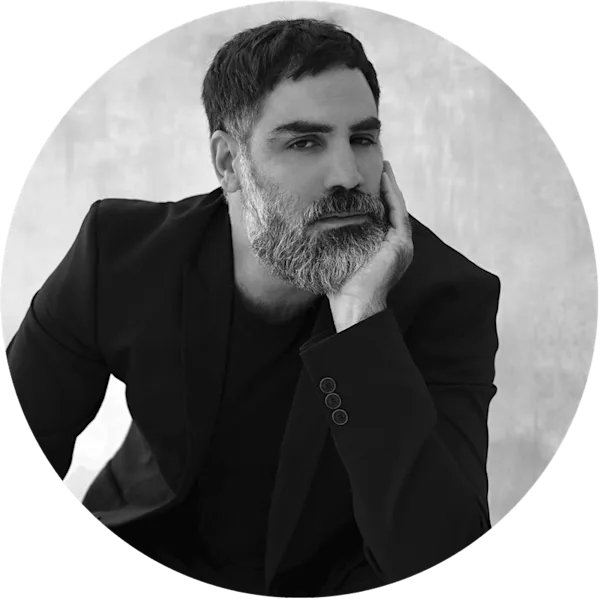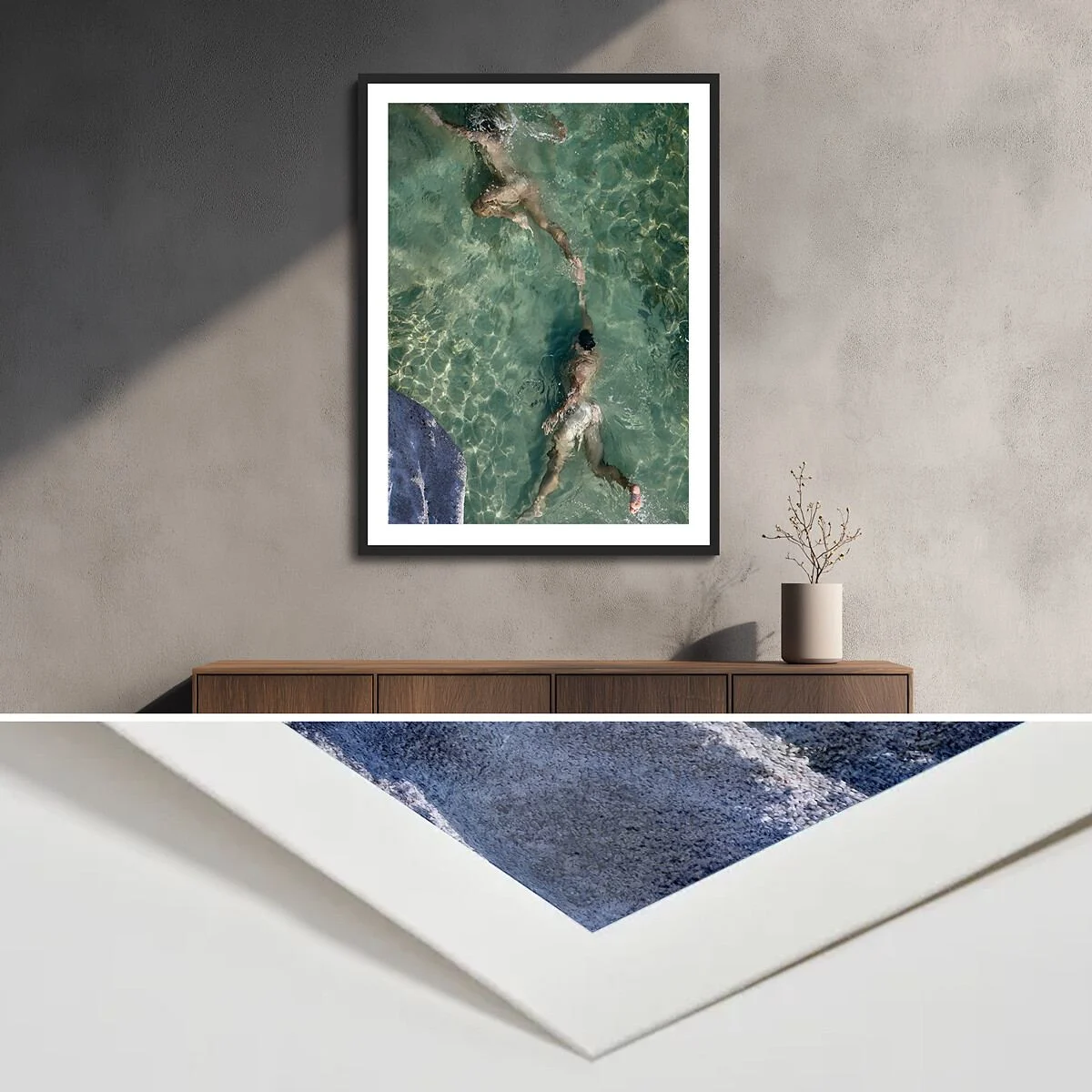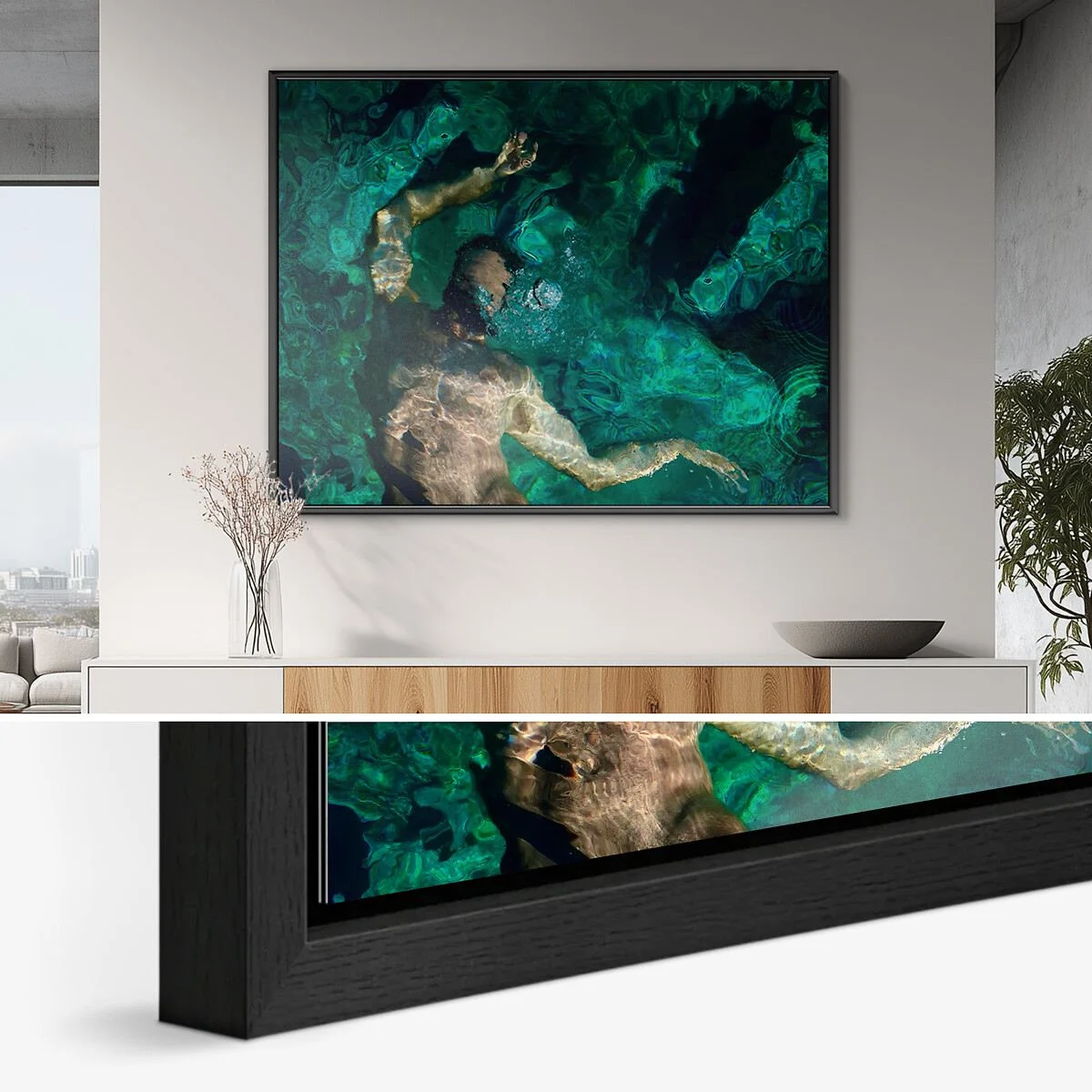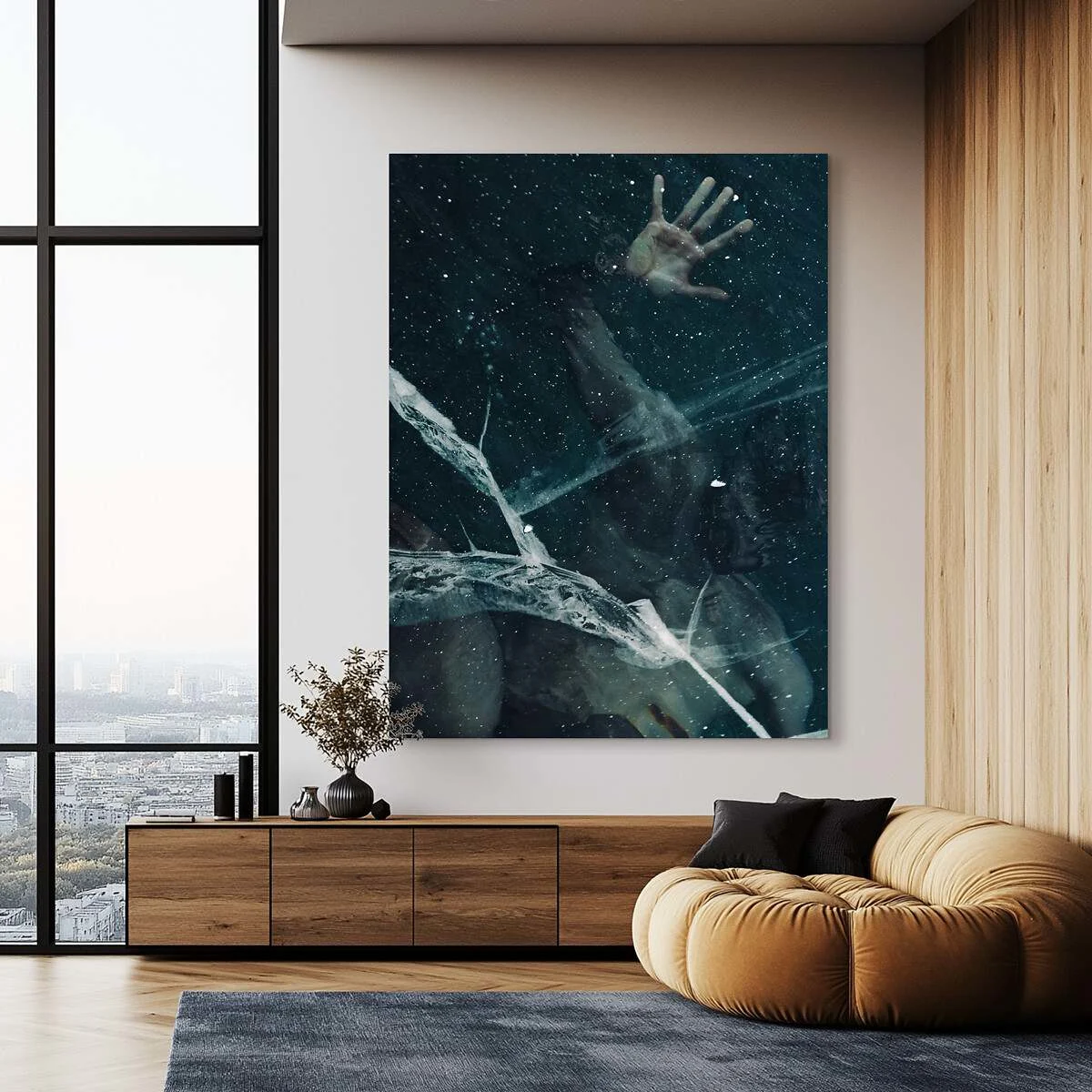The sea does not follow instructions – Interview with Michalis Goumas
Michalis Goumas
Michalis Goumas (born 1984) is a Greek artist and photographer. He lives between Athens and the Cycladic Island of Kythnos. His works range between painting and photography and reflect an intense exploration of form, texture, and perception. Exhibitions have already taken him to Greece and the USA, with further stops planned in Belgium.
In this interview, he talks about his unique approach to underwater photography, how he finds the decisive moment, and why Renaissance figures inspire him. He also talks about his collaboration with WhiteWall and emphasizes why printed work is indispensable to him: “I make limited-edition prints because I believe in tangible art—something that can be lived with.”

Interview with Michalis Goumas
1. Can you tell us a little bit about how you became an artist?
I started with painting. It was my first way of understanding the world—through texture, rhythm, and tone rather than words. Photography came later, not as a shift but as an expansion. I never set out to become a photographer; I turned to the camera when moments felt too fleeting for paint. I wasn’t interested in technical mastery or staged perfection. I was drawn to what felt instinctive: how light moved on skin, how salt lingered, how gesture held emotion.
My first serious exploration of this was Summer Renaissance. It wasn’t about concept—it was about response: to bodies in motion, to water and stillness, to how presence can speak before language. I never saw painting and photography as separate practices. Painting taught me discipline and patience. Photography brought immediacy. Together, they form the language I trust most.
I don’t think in terms of labels. I see myself as someone who observes and tries to hold onto what would otherwise slip away. If something stirs me—if it feels lived, not constructed—I follow it.
2. Please share something about your images. What is your special interest? How do you choose colors, composition, themes, etc.?

Photo: Michalis Goumas - The motif is printed on Hahnemühle Photo Rag Ultra Smooth Fine Art paper. Its velvety surface and matte finish give the motif a particularly harmonious effect. The passe-partout frame lends both lightness and depth.
What draws me in is what sits just beneath the surface—the emotional undercurrent of a scene. I often begin with atmosphere: the warmth of stone, the hush between gestures, the echo of movement just past. I want the viewer not just to see the image, but to feel it.
I work with natural light and color. My palette is shaped by my surroundings—dusty earth, Aegean blues, soft grays. I avoid heavy manipulation; I let imperfections shape the tone. Compositionally, I lean toward openness and asymmetry—space where something quiet can unfold.
Recurring themes—like the male form, the sea, solitude—aren’t planned. They return because they reflect my environment and the way I look. I don’t build narratives; I notice. The body, for me, isn’t symbolic. It’s terrain—vulnerable, changing, and real.
3. Your work is known for its exceptional details and compositions. How do you approach capturing moments to achieve that unique emotional depth?
It begins with being fully present—not just as an artist, but as a person. I don’t rush into photographing. I wait. I spend time simply observing, letting something more than aesthetics take shape. What I’m drawn to is the moment before awareness—the flicker before a glance, the breath before a gesture.
That kind of depth doesn’t come from control. It comes from trust. I rarely direct. I might start with a suggestion, but then I step back. I wait for something genuine to surface.
Technically, I keep things simple: natural light, a fixed lens. But it’s not about gear. It’s about intuition—knowing when not to shoot. Some of my most resonant images were taken when the session had, in theory, already ended. There’s often a kind of honesty that arrives once expectation leaves the frame.
4. Your portfolio showcases an impressive variety of themes and perspectives. How do you choose the stories you want to tell, and what inspires you to capture them?

Photo: Michalis Goumas - The characteristic pearlescent sheen of Hahnemühle FineArt paper enhances the expressiveness of the underwater photograph. The Basel shadow gap frame in black oak gives the motif a clear, elegant setting.
I don’t begin with stories. I begin with attention. I place myself in a space—a quiet room, a shaded path, a stretch of shoreline—and I stay open. What I wait for is not narrative, but feeling. A tone. A shift in the air. From there, the rest tends to unfold naturally.
Certain themes return—intimacy, stillness, the sea—not by design, but because they echo something internal. I watch for small gestures: the way someone rests their hand, how water clings to skin, the quiet weight of a gaze. These things open emotional space.
Sometimes I sketch beforehand—an impression I want to hold—but once I’m in the moment, I let the plan dissolve. What matters is sensitivity: letting someone exist without pushing them into image. The space between awareness and instinct is where everything begins.
5. Your underwater series is inspired by Renaissance paintings. How did you come up with this idea and what challenges did it pose?
I’ve always been drawn to the balance and stillness of Renaissance figures—their sense of suspension between movement and restraint. When I began photographing underwater, I immediately felt that same quality. Water changes everything: it slows the body, bends the light, dissolves weight. The result felt timeless—like stepping into a moving fresco.
At first, I tried to guide the scenes. I brought sketches and references. But the sea doesn’t follow direction. I had to let go. When I did, the images became looser, truer. The water dictated its own rhythm. Buoyancy shaped the pose. Light became unpredictable, and that unpredictability added depth.
Of course, there were challenges: breath control, staying calm, building trust with someone in a vulnerable state. But those limits actually helped. They created a closeness that carried into the frame. You can’t fake anything underwater. Every movement counts. Every ripple tells.
6. Many photographers talk about the importance of “the right moment.” Is there a particular moment or encounter that you consider a turning point in your career or artistic development?
Yes—but it was quiet, even forgettable. I was walking alone near a cove on the island, no camera in hand. The light was soft, the sea still, and time felt suspended. Nothing happened, really. But something settled in me.
Up to that point, I had been trying to “make” the image. That day, I understood I didn’t need to. I needed to notice. The most meaningful moments don’t announce themselves. They ask to be received, not captured. That shift—from effort to awareness—changed how I work.
Since then, I’ve interfered less. I listen more. I don’t need to explain the image if it holds feeling. That one small moment didn’t produce a photograph—but it changed the way I see. And that, to me, was the actual turning point.
7. You've chosen specific products to showcase your work. What materials and formats did you select, and why did you decide to go with those for your artworks?

Photo: Michalis Goumas - The photo print behind acrylic glass ensures intense colors and impressive depth. The frameless lamination makes the large format appear almost weightless.
I chose materials that reflect the tone of each piece. For my photographs, I use acrylic glass and fine art paper. Acrylic enhances clarity and depth, especially in underwater work. It gives the image a luminous quality. Fine art paper, by contrast, softens the mood. It absorbs light and suits more meditative scenes.
For my paintings, I keep them as they are—oil on canvas. The material holds the story. It’s not something I try to reproduce. Each choice comes down to what best preserves the presence of the work.
8. You produce your photographic prints through WhiteWall. What led you to choose this platform, and how does it support your process as a visual artist—both in terms of quality and day-to-day workflow?
WhiteWall offers the consistency I need when sharing work with collectors and clients. Their printing—on acrylic or fine art paper—aligns with the level of detail I want to maintain.
What helps most is that I can stay focused on the creative process. They handle printing, packaging, and delivery, which keeps things simple and efficient. I don’t need to manage every step, and the result always meets the standard I hold in the studio.
It’s become a practical part of how I work—quiet, dependable, and aligned with the integrity I try to carry through my images.
9. What else should we know about you?
I’m Michalis Goumas. I live between Athens and the island of Kythnos. I work across painting and photography, and I’m drawn to the quieter moments—those that ask for stillness and attention.
My surroundings shape how I see: the dry wind, the bare stone, the weight of summer light. I move slowly. I don’t chase the image—I wait for it. I make limited-edition prints because I believe in tangible art—something that can be lived with.
My work has been shown in Greece, the U.S., and soon in Belgium. But I value quiet impact more than visibility. If an image stays with someone—softly, without demand—that’s what matters to me. I’m not interested in spectacle. I’m interested in closeness. That’s what I try to offer.
WhiteWall Product Recommendations
You might also like these articles:
Submitted by WhiteWall Team
Between wildflowers and film rolls – Interview with Tiffany Newman
She shoots analog, trusts her intuition, and often finds the best subjects in chaos: Tiffany Newman takes us into her world of wildflowers, colors, and magical moments in nature. In this interview, she talks about how she got into photography as a kid, why a hailstorm in the Dolomites led to her favorite pictures, and what advice she has for young photographers who want to develop their own style.
Submitted by WhiteWall Team
In search of the essential with Alexander Schoenberg
Alexander Schoenberg's love of photography began unexpectedly with a doctor's recommendation that he should simply go for more walks. Photography became a kind of therapy for him, a medium that allowed him to capture his personal view of everyday scenes and objects.
Submitted by WhiteWall Team
Magical underwater worlds – Hengki Koentjoro
Hengki Koentjoro was born in 1963 in Semarang in Central Java, Indonesia. He received his first camera, a Kodak Pocket, as a gift for his eleventh birthday. From that moment on, photography was his passion and he trained first in Jakarta and then at the Brooks Institute of Photography in Santa Barbara, California.








